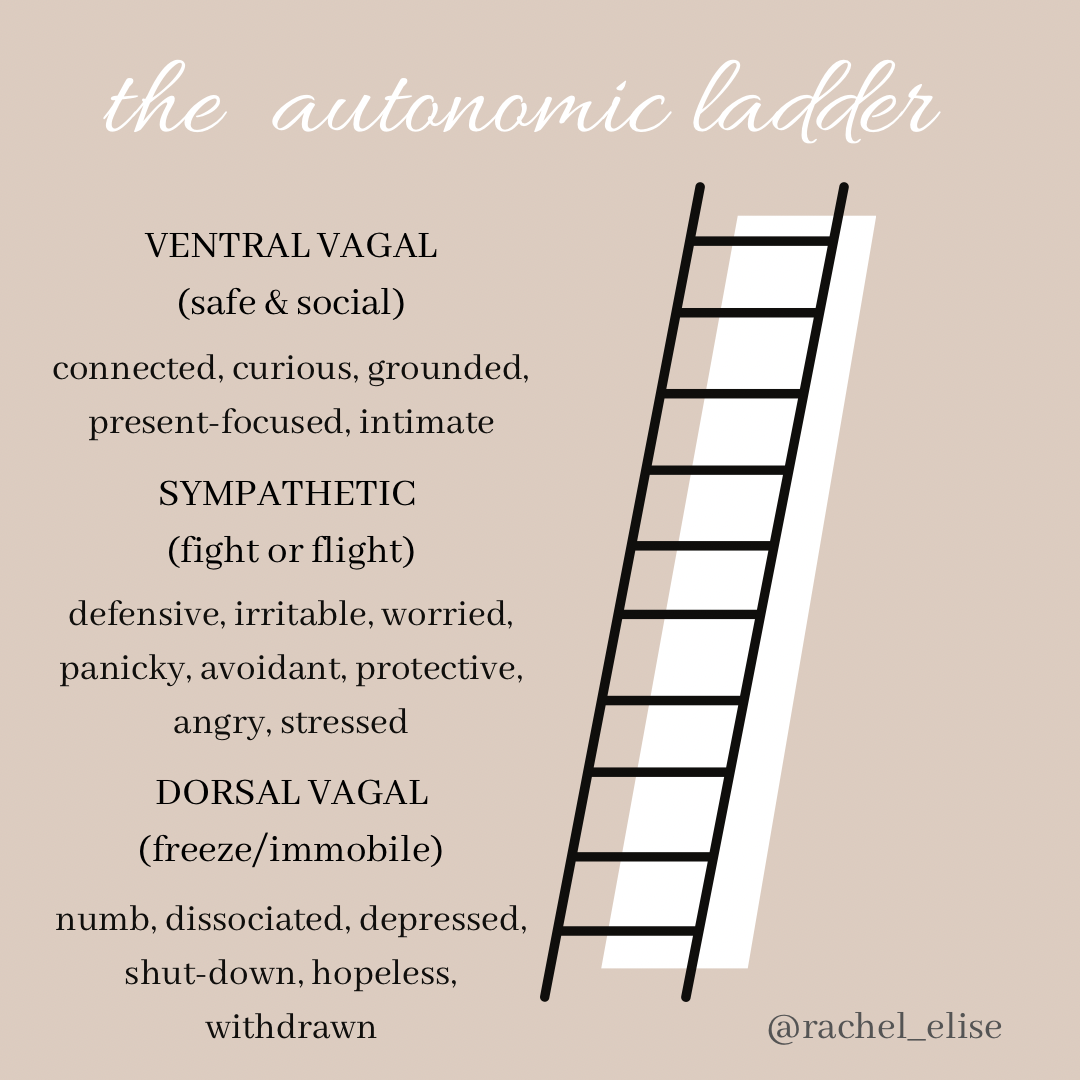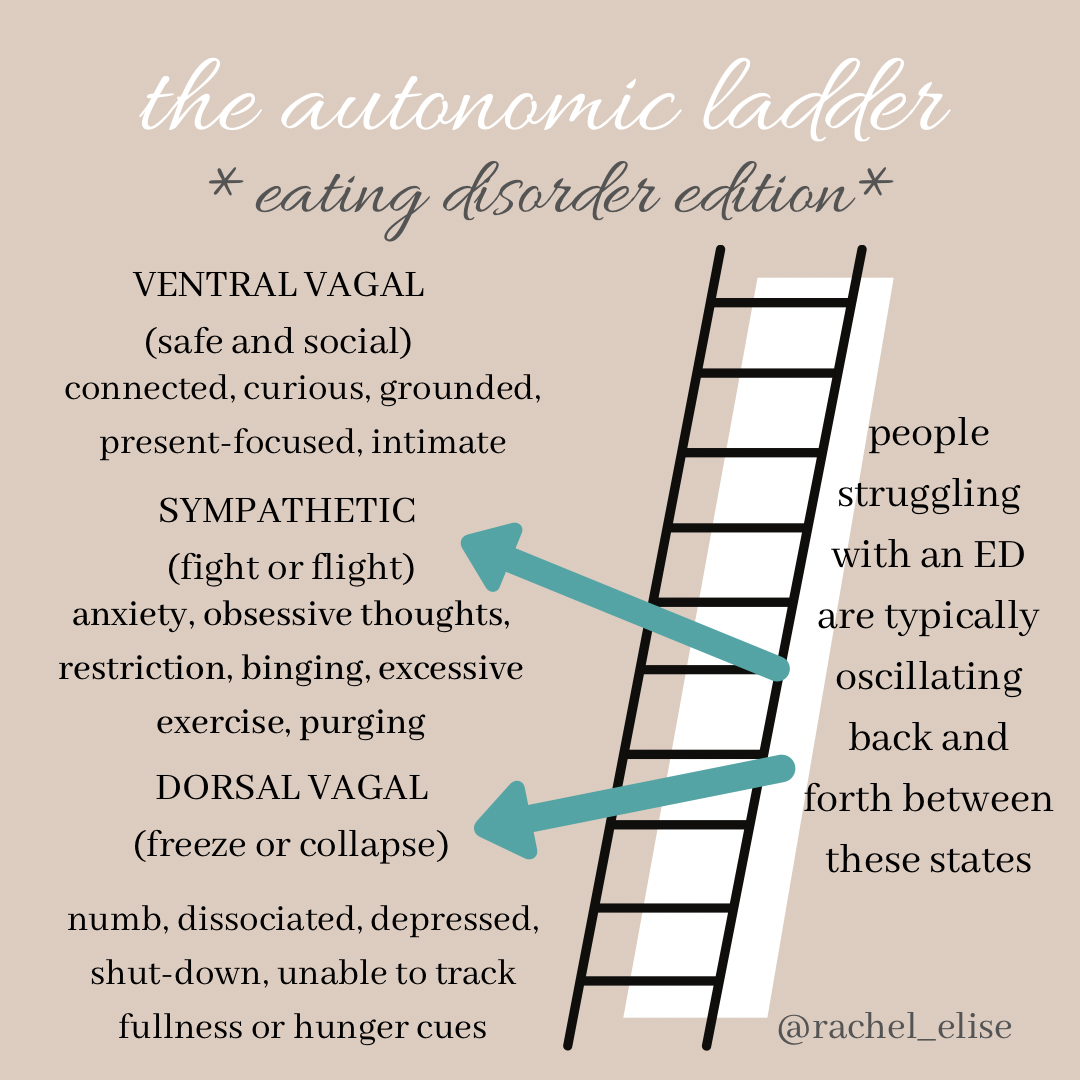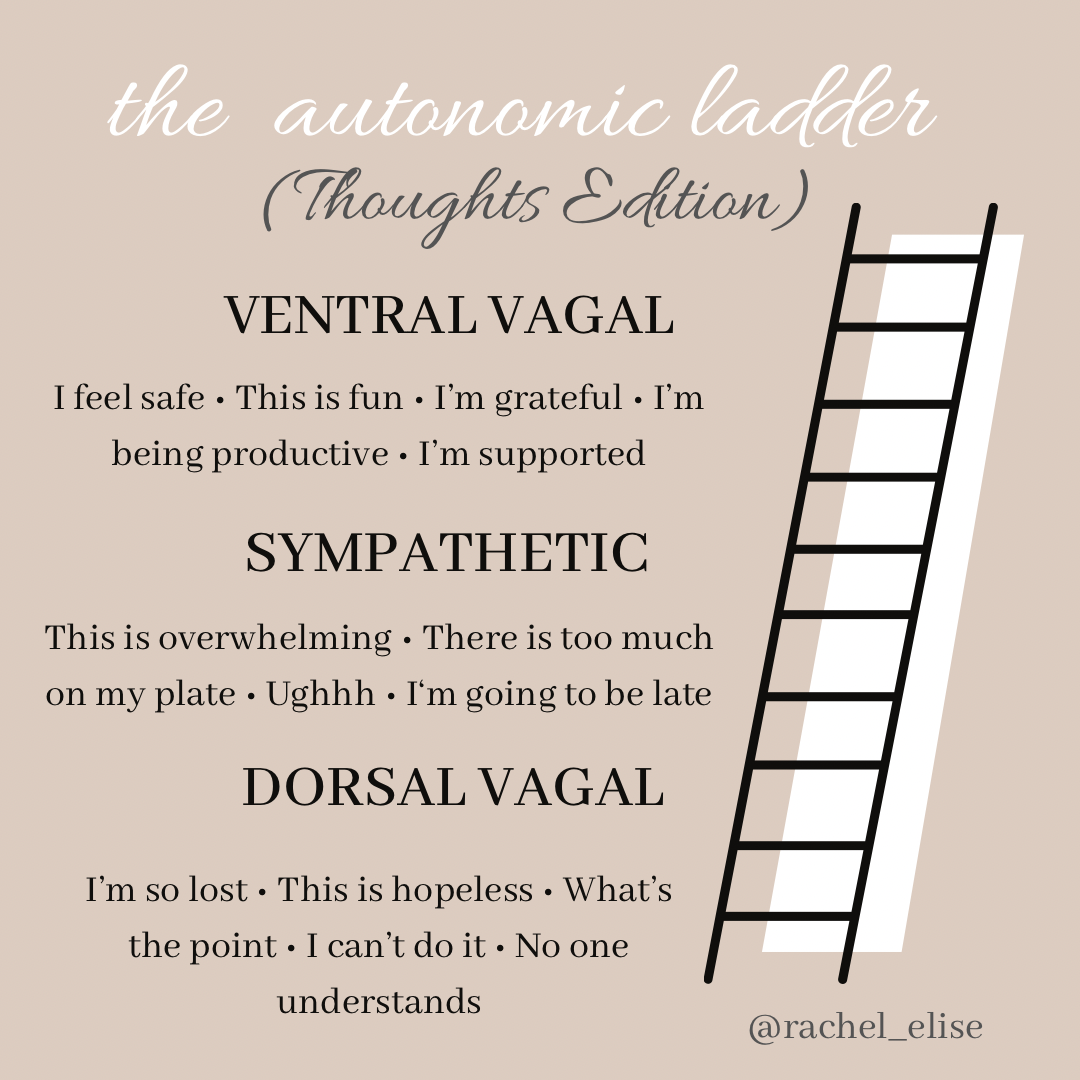The Polyvagal Ladder
The Polyvagal Ladder is a great visual to help you understand and remember Polyvagal concepts. It’s a great visual “map” to help remind you of the different parts of your autonomic nervous system. It’s a fantastic tool for self-regulation. Deb Dana, therapist and Polyvagal master, created this tool to help clients in therapy be able to track their various states and become more aware of what moves them up and down the ladder. Now, before you read on, I want you to pause and go read the previous two blog posts if you haven’t already. Those lay the groundwork for you to be able to get the most out of this post.
Whether you are in therapy or not, everyone can benefit from this tool. Like I’ve said before, many of us have been conditioned to live unconscious lives. Awareness and consciousness are things to be cultivated, it takes work and intentionality. Autopilot is easy. Conscious living is NOT and yet, consciousness and awareness are necessary for self-awareness and change.
So what exactly is the Polyvagal Ladder?! To learn about it, I’m going to ask you to visualize a mental picture in your brain. It will help with comprehension.
I want you to bring to mind a picture of a ladder. This ladder isn’t super tall nor is it super short. It’s pretty average. Maybe it’s resting on a house or maybe it’s inside. There are three distinct sections of this ladder. I want you to imagine yourself on the top of the ladder, the part farthest from the ground.
The top of the ladder is the Ventral Vagal System or the Social Engagement System, the most advanced part of our nervous systems. When our body is in this state, our heart is regulated, our breath is rhythmic and full, we are connected with friends and family, and feel energized. We might feel grounded, peaceful, productive, and present-focused. When in this state, our perception of the world is safe and fun. In this state, we feel regulated and feel just an overall sense of wellbeing and ease. You might feel calm or playful. Some of your thoughts might be, “I feel safe”, “This is fun”, “I am grateful”, and “I’m being productive, yay me!”
Now I want you to visualize yourself taking a few steps down the ladder, into the ladder’s mid-section. This is your Sympathetic system, the “fight/flight” state. This system is activated when we feel a sense of unease, anxiety, or fear, when our bodies “neurocept” a physical or emotional threat. Outside of conscious awareness, our bodies shift us down the ladder and move us farther away from our Social Engagement System. Here, we move into action, ready to self-protect. We might feel anxious, worried, angry, chaotic, disconnected, and irritable (thanks to the stress hormones cascading through our bodies). Some of your thoughts might be, “This is overwhelming”, “There is too much on my plate”, “I’m going to be late”, or for me, it’s usually just a phrase full of curse words. This state might feel really familiar for you, especially after the year 2020, one that was full of fear and anxiety.
Okay, bring back that image of the ladder. I want you to take a few steps down, to the bottom third of the ladder, the section closest to the ground. This is your Dorsal Vagal System. When the Sympathetic nervous system is too aroused for too long (like what we see with developmental/complex trauma and chronic stress), this is the system that takes over and shuts us down. To state it really simply, we move from feeling over-energized to feeling under-energized, from stressed out to depleted. Your Dorsal Vagal system does have a really positive function, as it helps us move between activation and into a state of relaxation. But we weren’t intended to live in a predominately Dorsal Vagal state. This system is often our last resort. We become collapsed and shutdown. You might feel hopeless, desperate, tired, and dissociated. The body has shifted into conservation mode—trying to hold onto whatever energy it has left to keep us alive. Some of your thoughts in this state might be, “This is hopeless”, “What’s the point”, “I can’t do this”, “No one understands.”
Okay, give yourself a pat on the back because you just absorbed a lot of new information! I hope that the visualization helped. Let me recap one more time.
Top of the ladder—safe and social
Middle of the ladder— sympathetic activation (mobilization)
Bottom of the ladder—parasympathetic shut-down (immobilization)
Some might think— wouldn’t it be nice if we could stay at the top of our ladder all the time?! Well yes, if we lived in a utopia, but mainly no. Because if our body didn’t have the capacity to move down the ladder, we wouldn’t have any means of protecting ourselves from danger when we need too. We wouldn’t have the capacity to “sense” it and respond accordingly. So, we need our Sympathetic and Dorsal systems, they’re necessary for our safety and survival. We see this in truly dangerous or life-threatening situations, but we also see it in everyday life.
Imagine you’re coming up on an important deadline for work or a fun, creative project. It’s so helpful to have that Sympathetic energy, that adrenaline rush, to help get you to the finish line! It’s also really nice to have that Dorsal energy kick in when you’ve reached that deadline and you’re ready to relax. None of these systems are necessarily “better” than the other, they just serve different purposes and functions. Health, balance, and wellbeing are all achieved when these systems are integrated.
I also want to say that typically, we aren’t just in “one” of these states. There is the concept of blended states, which I won’t go into too much detail here but I will briefly mention. The blended states are play, stillness, and freeze. When we’re in play, we’re Ventral dominant with a hint of Sympathetic energy. In stillness, we are Ventral dominant with a splash of Dorsal. And freeze tends to be a combination of Sympathetic and Dorsal. I say this simply to say: these states overlap! Think of these states more like dials, with the ability to turn up or down their intensity. In any given experience, the dials of all three states are turned up in varying degrees.
I’ve mentioned Deb Dana before, as she’s been one of my greatest teachers on this subject! She describes these systems and how they work together using the metaphor of a house. And I want to share it with you!
Dorsal Vagal system runs the “basic utilities” of the home. Think of this system as an empty house, like one whose family just went on vacation. They turned everything to the lowest possible setting, enough to keep things functioning while they’re away. Since the Ventral vagal system isn’t activated here, it’s basically like “no one is home” (Dana, 2018).
The Sympathetic branch is like the home security system. It’s the house alarm. It’s designed to trigger a quick response to danger and then return to standby after the threat is resolved. Without the ventral vagal system or the presence/assurance of safety, the alarm just continues to sound (Dana, 2018).
The Ventral Vagal system is what brings comfort to the house. It can be enjoyed as a place of rest and community. We feel the basic utilities running and we know that the alarm system is there when we need it. This is what integration feels like, and because of that, we can be engaged, present, and connected to ourselves and others (Dana, 2018).
Okay, so now what? What’s the point of both of these metaphors anyways?
The point is this—awareness. This is all about awareness. Our culture devalues the body so much, and yet, awareness of the body and our emotions actually gives us really important insight about our mental health. Our bodies are always giving us cues as to where we are on our ladder, and we need to cultivate ears to listen. We weren’t designed to live only moving back and forth between our fight or flight and shutdown systems, and yet so many of us do. We ping-pong back and forth between anxiety and worry and then feeling totally hopeless and numb. This isn’t our fault (which I’ve said before), but we do get to acknowledge it, and when we acknowledge it and start to understand our nervous systems, then we can accept the invitation for regulation. But I can’t regulate myself and if I don’t understand what it is I’m regulating! That’s why this is important.
Beneath the surface of many mental illnesses and disorders is chronic nervous system dysregulation. So, if we want to start to improve our mental health, we have to start addressing our nervous systems and we have to start befriending them and getting curious about them.
We move up and down our Polyvagal ladder multiple times a day, and that’s a good thing! And what I want for you is to be able to tune into your thoughts, emotions, and physical sensations and ask yourself, “What state am I in right now?” Our thoughts, emotions, and physical sensations are all different depending on our state. The stories we tell ourselves about our world and our relationships are also totally dependent on our nervous system state.
I’m going to give you a few examples of what triggers me or sends me into one of these states. Maybe you can resonate with some of these, too!
My dorsal vagal system kicks in when I feel trapped in a situation, when I feel like I don’t belong, or when my voice doesn’t feel heard, and when I don’t feel appreciated for who I really am. This system also kicks in when I’m watching the news (especially in 2020). I immediately feel so helpless and disturbed.
My sympathetic nervous system kicks in when I have too much on my plate, am engaging in conflict with my partner, when I ignore my own needs or don’t set boundaries, when I’m running late or not being productive at work or when I’m worried about the future or finances.
My ventral vagal system kicks in when I’m in nature, dancing in my apartment, cooking a meal with my husband, reading a book, traveling, or going on a walk.
Once we can identify what state we are in, then we can ask ourselves, “What can I do or what might I need to do to regulate? How can I climb back up my ladder?”
Remember how I talked about the concept of faulty neuroceoption, and how the experience of trauma (which we all have) has led to our bodies to detect danger even in the presence of safety? We get to be more conscious and aware of when this is happening, and we get to learn tools and strategies that can help us climb back up our ladder and into a state of mindful awareness.
I made a couple of graphics about the Polyvagal Ladder that I’ve shared on the Instagram account (Rachel_elise). I hope these visuals will help solidify this knowledge for you!
May you be well. And may you get curious,
Rachel



